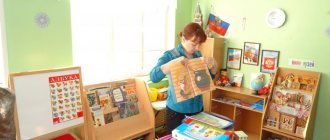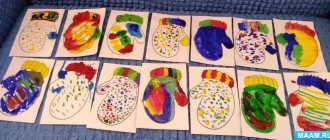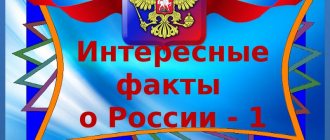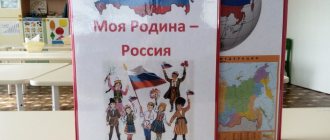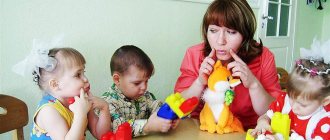Goal: to expand and consolidate children’s knowledge about the state symbols of the Russian Federation, their historical origin and meaning. Instill love and educational interest in the history of your homeland. Objectives: Educational: - Summarize and systematize children’s knowledge about the state symbols of Russia - the flag, coat of arms, anthem. — Form a grammatically correct structure of speech, answering questions with a complete, detailed sentence, using an accurate, expressive vocabulary. Developmental: - To develop in children a sense of patriotism and love for their Motherland. — To develop in children emotional responsiveness to music, poetry, folklore. — Develop children's horizons. Educational: - To develop a respectful attitude towards the state symbols of Russia, an understanding that they are designed to unite the residents of one country. — To cultivate love and pride for the Motherland, family, for the Russian people, respect for its traditions. Integration of educational areas: speech development, artistic and aesthetic development, social and communicative, cognitive development, physical development. Preliminary work: -Learning poems about the Motherland, nature; songs, nursery rhymes, round dances; -Reading works of Russian writers about the Motherland and people; -Examination of illustrations, books, albums, postcards about Russia and our region; -Listening to music; -Excursions to the local history museum, to places of interest in the village; -Conversations about the traditions and folk crafts of the Russian people; -Drawing, making applications on this topic; didactic games. Materials and equipment: Laptop, TV, presentation for children “Russia is my Motherland”; colorful illustrations of state symbols of Russia, the village of Dmitrievka; record player; audio recording of the national anthem of the Russian Federation; audio recording of Yu. Antonov’s song “Native Side”, song “White, Blue, Red”. Game puzzles for the didactic game “Collect the coat of arms of Russia.” Signal cards for the didactic game “White - Blue - Red”. Didactic game “Who lives in which country?”
Progress: 1. Organizational moment. Children are included in the group: Educator: We are all friendly guys. We are preschool children. Let everyone be well, May it be joyful and light! -Let's give each other smiles. It is with such a joyful mood that I invite you to the virtual journey “My Motherland is Russia!” 1. Main part. Educator: - Guys, let's go to our book corner. I have prepared an exhibition of interesting illustrations for you. Look what is shown on them? Did you find out? (a verse of Yu. Antonov’s song “Native Side” sounds in the recording). Children: - This is our village. Educator: - Yes, that's right. These are bright and memorable places in our native village of Dmitrievka, our small Motherland! - Motherland! Everyone knows this word from childhood. Homeland is the place where you were born, where you live with your parents, with your friends. -Guys, our small Motherland is our Tambov region, our working village of Dmitrievka, which is 382 years old since its formation. Who knows what our country is called? Children: - Russia! Educator: - Yes, of course, Russia! The largest and most beautiful country in the world. -Guys, come and sit on the chairs. Our journey continues. Educator: -Now let’s listen to the poem: Child: Great land, Beloved land, Where we were born and live. We are the bright Motherland, We are the sweet Motherland, We call it our Motherland. (Show slides 1-4 of the presentation “Russia is my Motherland”) Educator: - Russia has the largest rivers, the deepest lake - Baikal. How diverse is the nature of our Motherland, how many cities, how diverse are the occupations of people in different parts of the country. At all times, poets, writers, composers, artists sang of our beautiful Motherland and dedicated their wonderful works to it. Educator: - Let's play a game: “Who lives in which country?” (goal: to consolidate the names of countries, the population of these countries, to form an understanding that there are many different countries in the world), and let’s remember the inhabitants of different countries. Educator: (a question is asked, the children answer). -Who lives in America? - Americans. -Who lives in Russia? – Russians, etc. Educator: - Yes, well done, we played well. Russia is a state with its own laws, traditions, and government. (Slide show 5-7 of the presentation “Russia is My Motherland”) - Each country has many cities, but there is a main city - this is the capital. — What is the name of the capital of our state? Children: - Moscow. Educator: — The government of the Russian Federation and our president work in Moscow. — What is the name of the President of the Russian Federation? Children: - Vladimir Vladimirovich Putin. Educator: - Correct. Each country, each state has its own distinctive signs, state symbols - a flag, coat of arms and anthem. These are symbols that unite citizens of one country, you and me. They must be treated with respect. Today we will get acquainted with these symbols. (Show slides 8-9 of the presentation “Russia is My Motherland”) Educator: - One of the symbols is a flag. The flag symbolizes our Motherland. It flies over the government building, the flags are hung during holidays, and raised during victories, for example, at international sporting competitions. “And many centuries ago, instead of a flag, people used a pole with a bunch of grass tied to its top, painted with bright paint. This was called a banner. Its main purpose was to gather, “pulle together” warriors to defend their land. (Show slides 10-11 of the presentation “Russia is my Motherland”). — Guys, how can we recognize the Russian flag? Children: - The flag has three stripes. Educator: - Well done, that's right. Our flag is often called the tricolor. The arrangement of white-blue-red stripes familiar to us was first introduced by Tsar Peter 1. The stripes are arranged horizontally. Colors are associated with folk ideas of beauty. These colors have long been considered the most beautiful in Rus', and were even used to decorate festive clothing. (Slide show 12-14 “Russia is my Motherland”). Educator: - Each stripe has its own meaning. Remember what the white color of the flag means? Children: (Children's answers). Peace and purity. Educator: - What does the blue color of the flag mean? Children: (Children's answers). Loyalty and truth. Educator: - What does the red color of the flag mean? Children: (Children's answers). Courage and bravery, strength, blood shed for the Fatherland. Educator: - Yes, guys, you correctly named the meanings of each color on the flag. Our country is strong and peaceful. -During the Great Patriotic War, soldiers with a flag in their hands went into battle, and, clearing the country of fascist invaders, hoisted the flag in the most visible place. This showed that a given city, village, village, temporarily occupied by enemies, was freed from enemies. Educator: - Now let’s play a game for attention: “White - blue - red.” -Show white - clap your hands; blue color - stomp your feet; red - shout: Hurray! Physical education is carried out in the form of a game for attention. Educator: - Great, everyone played very carefully and rested a little. -Now let's talk about the coat of arms. Coats of arms appeared a long time ago. This was the distinctive sign of the knights. It served so that warriors clad in iron armor could be distinguished from each other. (Slide show 15-17 “Russia is my Motherland”). We have a beautiful coat of arms, it depicts a double-headed eagle. Look what bird is an eagle? Children: - Proud, beautiful, strong. Educator: - The eagle is a symbol of the sun and heavenly power, immortality. The double-headed eagle on the coat of arms appeared a very long time ago. Inside the coat of arms, on the chest of the eagle, is the coat of arms of the city of Moscow. St. George the Victorious pierces a dragon with a spear. The dragon is the evil that exists on earth. The coat of arms is the emblem of the state. It is depicted on all seals, banknotes, passports, and documents. This coat of arms was approved on December 25, 2000. Educator: - Now let’s play the game “Collect the coat of arms of Russia.” First, let's split into two teams. Your goal: whose team will assemble the coat of arms of Russia from game puzzles faster and correctly. Let's start. Educator: - Well done. Friendship won! Now tell me what kind of music will sound now. -I ask everyone to stand up. (The Russian anthem plays) Children: - This is the anthem. Educator: - Yes, you are right. Listen to the lines of T. Popova’s poem: What is an anthem in general? The main song in the country! The Russian anthem contains the following words: “Russia is our beloved country.” We are proud of Russia, we are loyal to Russia, and there is no better country in the world! We always listen to the anthem standing and silently: It is played for us at the moment of celebration! (Slide show 18-20 “Russia is my Motherland”). Educator: -The anthem is played on especially solemn occasions: at conferences, at meetings, concerts, military parades, in honor of the best people of work, at the opening and closing of sports Olympics, in honor of winning athletes, when presenting awards to them, when presenting awards to cities - heroes, at the opening of monuments and memorial signs. To listen to the anthem, you need to stand and not talk. 2. Final part. Educator: - Guys! Today we took a virtual journey through the history of our Motherland and looked into the history of the creation of state symbols of Russia. All citizens of Russia are proud of the State Emblem, flag and anthem. Not a single important event is complete without these distinctive signs of the country. Cases of use of the coat of arms, flag and anthem of Russia are determined by law. We got acquainted with the state symbols of the greatness and power of Russia. We inherited them from our ancestors. What they will become in the future depends only on us. Russia is a great country that has a rich and glorious history. We are citizens of a multinational country who should be proud of our country, its traditions, and cultural heritage. To love and in moments of danger to defend your Fatherland. You, the children of Russia, are the hope and future of our country. You all did great today: you were attentive, active, and smart. And at the end of our virtual journey, I invite you to sing the song “White Birches, White Snows...” (the recording of the song “White, Blue, Red” is played).
Literature: Pchelov E.V. State symbols of Russia. Coat of arms, flag, anthem. M.: Russian Word, 1993. V.V. Vaskin Children's encyclopedia “Russian State Symbols”, 2002. Methodological manuals: 1. Danilina P.N. For preschoolers, about the history and culture of Russia: A manual for the implementation of the state program “Patriotic education of citizens of the Russian Federation for 2001-2005.” M.: ARKTI, 2003. 2. Erokhina E.L., Kruglova T.A. State symbols of Russia. Flag; coat of arms, anthem. M.: Yuventa, 2002. 3. Aleshina N.V. “Familiarization of preschoolers with the environment and social reality” (preparatory group). M.:UC “PERSPECTIVE” 2016 4. Rivina E.K. Coat of arms and flag of Russia. We introduce preschoolers and primary schoolchildren to state symbols. M.: ARKTI, 2002.
Topic: Our country. My native land. Where does the Motherland begin?
Correctional educational goals:
— introduce children to the flag, anthem and coat of arms of Russia.
Corrective and developmental goals:
- strengthen the ability to form adjectives from nouns; - develop the ability to coordinate words in sentences; - activate the dictionary on the topic.
Corrective educational task:
- cultivate a sense of pride in your country.
Equipment: map of Russia, plot pictures during the lesson, pictures depicting animals, plants and birds living in various places on the planet, pictures depicting the flag, coat of arms of Russia, recording of the Russian anthem.
Progress of the lesson:
1. Organizational moment.
The children sit at the tables. The speech therapist reads the poem “Where does the Motherland begin?”
Where does the Motherland begin? From the picture in your primer, From good and kind comrades, Living in the neighboring yard. Or maybe it begins, With the song that our mother sang to us, With the fact that no one can take it away from us in any trials.
2. Announcement of the topic.
Today in class we will talk about what the Motherland is for every person and where it begins.
3. Introductory conversation.
So where does the Motherland begin? Homeland is the country in which you were born, it is the house in which you live, it is your family and friends.
Our home, city, country.
Our country is Russia. Each country has a flag, anthem and coat of arms. Our Russian flag has three stripes. White means purity and justice. Blue is a peaceful sky. Red - strength and beauty. This flag was introduced into Russia by Tsar Peter 1. When the national anthem is played and the national flag is raised, the citizens of this country stand up. Each country also has its own coat of arms. The coat of arms of Russia is a double-headed eagle.
You live in a city, town or village, and this place is necessarily marked on the map. But besides this, each person has his own home. People all over the world live in a wide variety of homes. They build them from various materials. Some houses are built of brick or stone, others of wood, clay or reeds.
4. Development of lexical and grammatical categories.
Game "Where do I live?"
My country is called ... (Russia) The capital of our country is ... (Moscow city) My city (village) is called - ... My home address is -
Game “Which, which, which?” (Based on plot pictures)
A city in Russia is a Russian city. A village in Russia is a Russian village. Passport of a citizen of Russia - Russian passport. Moscow is the capital of Russia - the Russian capital. The people who live in Russia are the Russian people. Monuments of Russia – Russian monuments. Our Motherland, what is it like? - Immense, boundless, rich, beautiful, powerful, huge. What needs to be done to keep it that way? To love, cherish, protect, preserve her wealth. What are the people called who stand guard over the Motherland? (Defenders of the Fatherland)
Physical education minute.
There is no more beautiful Motherland in the world - (Children walk in place) A fighting country of heroes. (They portray “heroes”) Here it is, called Russia, (They walk in place) It stretches from the seas to the seas. (spread their arms wide) A. Prokofiev.
Game “Animals and Plants of the Native Land”
Find animals, plants and birds that live in Russia. (Children are offered pictures depicting animals, plants and birds living in various places on the planet.)
Game "Where will I go for a walk"
Children look at pictures depicting the sights of their native land and tell where they would like to go for a walk or go on a trip.
On weekends I will go for a walk with mom and dad to the park. And I’ll go on a hiking trip to the bank of our river, etc.
5. Summary of the lesson.
The speech therapist offers to listen to the Russian anthem and reminds us how to behave when the anthem of our native country is played.
